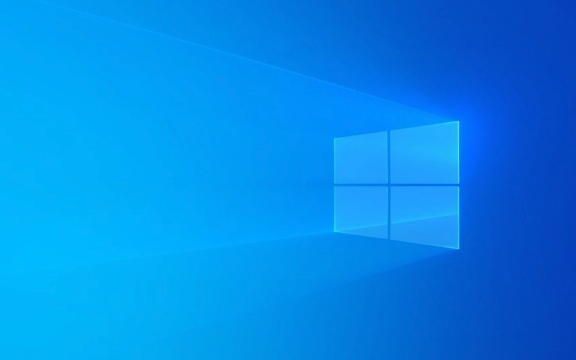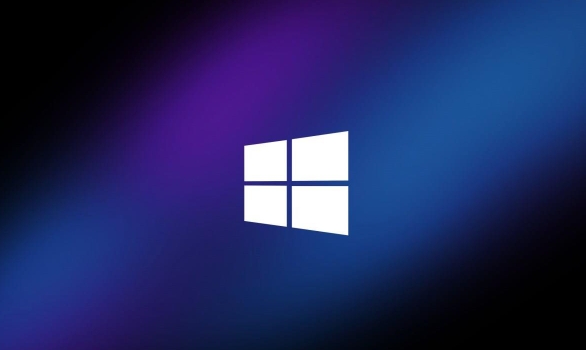How to troubleshoot a failed Windows installation
Aug 02, 2025 pm 12:53 PMVerify the Windows ISO is from Microsoft and recreate the bootable USB using the Media Creation Tool or Rufus with correct settings; 2. Ensure hardware meets requirements, test RAM and storage health, and disconnect unnecessary peripherals; 3. Confirm BIOS/UEFI settings match the installation media, including boot mode, Secure Boot, Fast Boot, and SATA configuration; 4. During installation, delete existing partitions for a clean setup, manually load storage drivers if needed, skip internet connection, and perform a fresh install; 5. Check for overheating and ensure stable power supply or laptop charging, as most failures stem from faulty media, hardware, or incorrect settings, which can typically be resolved step by step without professional assistance.

A failed Windows installation can be frustrating, especially if you're setting up a new PC or reinstalling after a system crash. However, most issues can be resolved by systematically checking common problem areas. Here’s how to troubleshoot a failed Windows installation effectively.

1. Check Installation Media and Source
One of the most common causes of a failed installation is corrupted or improperly created installation media.
- Verify the ISO file: Make sure the Windows ISO you downloaded is from the official Microsoft website. Check its integrity by comparing the SHA-256 hash (if available) with the one provided by Microsoft.
- Recreate the bootable USB: Use the official Microsoft Media Creation Tool or tools like Rufus with the correct settings (e.g., NTFS for UEFI, FAT32 for older BIOS systems).
- Try a different USB drive or port: Sometimes, a faulty USB stick or port can cause read errors during installation.
Tip: Avoid using third-party tools or modified ISOs, as they may contain errors or malware.

2. Verify Hardware Compatibility and Issues
Hardware problems are a frequent culprit in failed installations.
- Check system requirements: Ensure your PC meets the minimum hardware requirements for the version of Windows you're installing.
- Test your RAM: Use tools like Windows Memory Diagnostic or MemTest86 to rule out memory issues.
-
Check storage health:
- For HDDs/SSDs, use manufacturer tools (e.g., Samsung Magician, WD Diagnostic) to check drive health.
- Look for bad sectors or failing drives that can interrupt installation.
- Disconnect unnecessary peripherals: Unplug extra drives, printers, or external devices that might interfere with the boot process.
If you're installing on an SSD and get errors, ensure it’s properly seated (for desktops) or recognized in the BIOS.

3. Address BIOS/UEFI and Boot Settings
Incorrect firmware settings can prevent Windows from installing properly.
- Boot mode: Make sure the boot mode (UEFI vs Legacy/CSM) matches the installation media. If the USB was made for UEFI, ensure UEFI boot is enabled.
- Secure Boot: Try disabling Secure Boot temporarily if the installer doesn’t launch or fails early.
- Fast Boot: Disable Fast Boot in BIOS, as it can sometimes interfere with bootable media detection.
- Enable SATA mode properly: Set SATA mode to AHCI (not IDE or RAID) unless you have specific drivers.
If you're dual-booting or upgrading from an older Windows version, ensure the disk partition style matches (GPT for UEFI, MBR for Legacy).
4. Fix Installation Errors and Freezes
If the installer starts but fails at a specific point (e.g., 14%, 62%, or during driver setup), here’s what to do:
-
Clear the installation partition:
- At the drive selection screen, delete all existing partitions on the target drive.
- Let Windows create new ones automatically.
-
Load storage drivers manually:
- If the installer doesn’t detect your drive, you may need to load RAID or NVMe drivers. Download them from your motherboard or laptop manufacturer and load them using the “Load Driver” option.
- Disconnect from the internet: If the installation hangs during updates, skip connecting to Wi-Fi or Ethernet until after setup completes.
- Perform a clean install: Avoid upgrading in-place if the system was previously unstable. Format the drive and do a fresh install.
Common error codes like 0x80070002, 0x80070005, or 0xC1900101 often point to corrupt files or driver conflicts—double-check your media and drivers.
5. Check for Overheating or Power Issues
Less obvious but still relevant:
- Overheating: If the system overheats during a long installation, it may crash or reboot unexpectedly. Ensure fans are working and vents are clear.
- Power supply: On desktops, an insufficient or failing PSU can cause sudden shutdowns during installation.
- Laptops: Make sure the battery is charged or the charger is connected and working.
Basically, most failed Windows installations come down to bad media, hardware issues, or incorrect settings. Go step by step—start with the USB drive, then check hardware, then tweak BIOS settings. Most problems can be resolved without needing professional help.
The above is the detailed content of How to troubleshoot a failed Windows installation. For more information, please follow other related articles on the PHP Chinese website!

Hot AI Tools

Undress AI Tool
Undress images for free

Undresser.AI Undress
AI-powered app for creating realistic nude photos

AI Clothes Remover
Online AI tool for removing clothes from photos.

Clothoff.io
AI clothes remover

Video Face Swap
Swap faces in any video effortlessly with our completely free AI face swap tool!

Hot Article

Hot Tools

Notepad++7.3.1
Easy-to-use and free code editor

SublimeText3 Chinese version
Chinese version, very easy to use

Zend Studio 13.0.1
Powerful PHP integrated development environment

Dreamweaver CS6
Visual web development tools

SublimeText3 Mac version
God-level code editing software (SublimeText3)
 How to change the system display language for all users in Windows
Jul 31, 2025 am 08:18 AM
How to change the system display language for all users in Windows
Jul 31, 2025 am 08:18 AM
InstallthedesiredlanguagepackviaSettings→Time&Language→Language®ion,ensuring"SetasmyWindowsdisplaylanguage"isselected.2.Changethesystemdisplaylanguageinthesamemenuandrestart.3.OpenControlPanel→Region→Administrativetab,click"
 How to reset the Microsoft Store in Windows
Jul 31, 2025 am 08:23 AM
How to reset the Microsoft Store in Windows
Jul 31, 2025 am 08:23 AM
ResettheMicrosoftStoreviaSettingsbygoingtoApps>Installedapps,selectingMicrosoftStore,clickingAdvancedoptions,thenRepairandResetifneeded.2.Ifthatfails,re-registertheStoreusingPowerShellasadminwiththecommand:Get-AppXPackage-NameMicrosoft.WindowsStor
 How to install Windows on a Mac without Boot Camp
Jul 31, 2025 am 11:58 AM
How to install Windows on a Mac without Boot Camp
Jul 31, 2025 am 11:58 AM
Without BootCamp, installing Windows on Mac is feasible and works for different chips and needs. 1. First check compatibility: The M1/M2 chip Mac cannot use BootCamp, it is recommended to use virtualization tools; the Intel chip Mac can manually create a boot USB disk and install it in partition. 2. Recommended to use virtual machines (VMs) for M1 and above chip users: Windows ISO files, virtualization software (such as ParallelsDesktop or UTM), at least 64GB of free space, and reasonably allocate resources. 3. IntelMac users can manually install it by booting the USB drive: USB drive, WindowsISO, DiskU is required
 How to reset the TCP/IP stack in Windows
Aug 02, 2025 pm 01:25 PM
How to reset the TCP/IP stack in Windows
Aug 02, 2025 pm 01:25 PM
ToresolvenetworkconnectivityissuesinWindows,resettheTCP/IPstackbyfirstopeningCommandPromptasAdministrator,thenrunningthecommandnetshintipreset,andfinallyrestartingyourcomputertoapplychanges;ifissuespersist,optionallyrunnetshwinsockresetandrebootagain
 How to install Windows on a Mac
Jul 31, 2025 am 10:07 AM
How to install Windows on a Mac
Jul 31, 2025 am 10:07 AM
ForIntel-basedMacs,useBootCampAssistanttocreateadual-bootsystemwithWindowsbypreparingaUSBdrive,downloadingaWindowsISO,partitioningthedisk,andinstallingWindowsalongsidemacOSwithsupportdrivers.2.ForAppleSiliconMacs(M1/M2/M3),usevirtualizationsoftwareli
 Step-by-step guide to installing Windows from an ISO file
Aug 01, 2025 am 01:10 AM
Step-by-step guide to installing Windows from an ISO file
Aug 01, 2025 am 01:10 AM
DownloadtheWindowsISOfromMicrosoft’sofficialsite.2.CreateabootableUSBusingMediaCreationToolorRufuswithaUSBdriveofatleast8GB.3.BootfromtheUSBbyaccessingthebootmenuoradjustingBIOS/UEFIsettings.4.InstallWindowsbyselectingcustominstallation,choosingtheco
 A guide to custom Windows installation options
Aug 01, 2025 am 04:48 AM
A guide to custom Windows installation options
Aug 01, 2025 am 04:48 AM
Choose"Custom:InstallWindowsonly(advanced)"forfullcontrol,asitallowsacleaninstallthatremovesoldissuesandoptimizesperformance.2.Duringsetup,managepartitionsbydeletingoldones(afterbackingupdata),creatingnewpartitions,formatting(usingNTFS),ors
 How to manage AppLocker policies in Windows
Aug 02, 2025 am 12:13 AM
How to manage AppLocker policies in Windows
Aug 02, 2025 am 12:13 AM
EnableAppLockerviaGroupPolicybyopeninggpedit.msc,navigatingtoApplicationControlPolicies,creatingdefaultrules,andconfiguringruletypes;2.Createcustomrulesusingpublisher,path,orhashconditions,preferringpublisherrulesforsecurityandflexibility;3.Testrules







